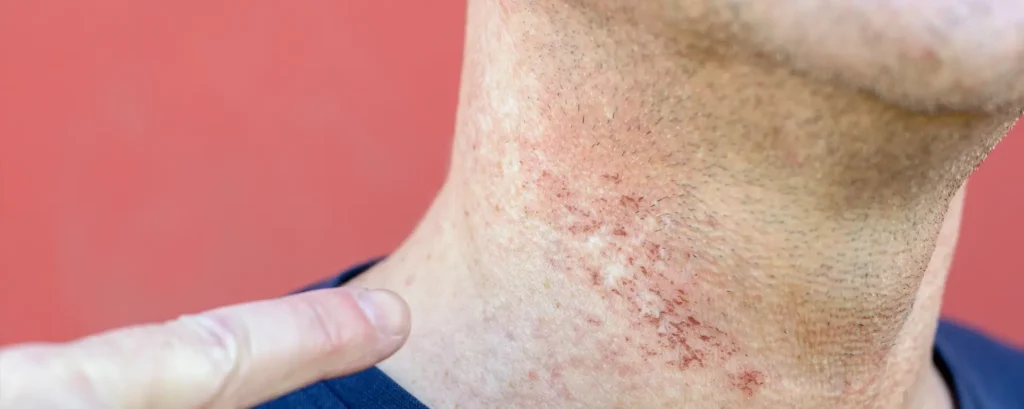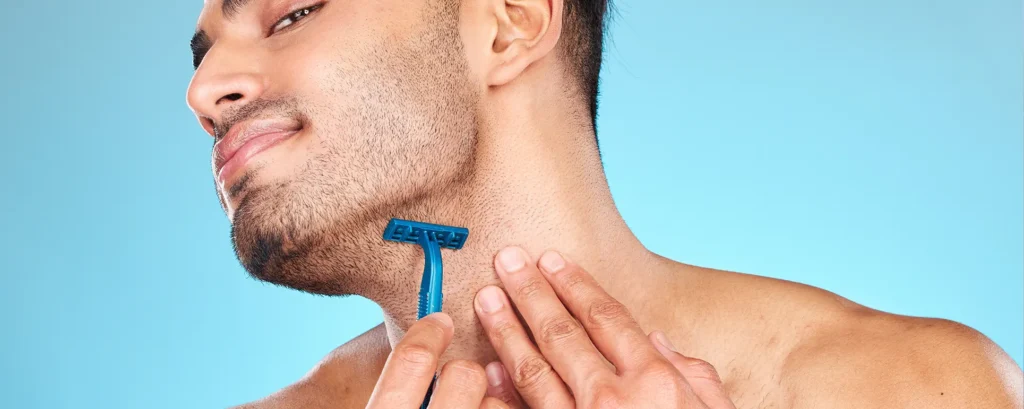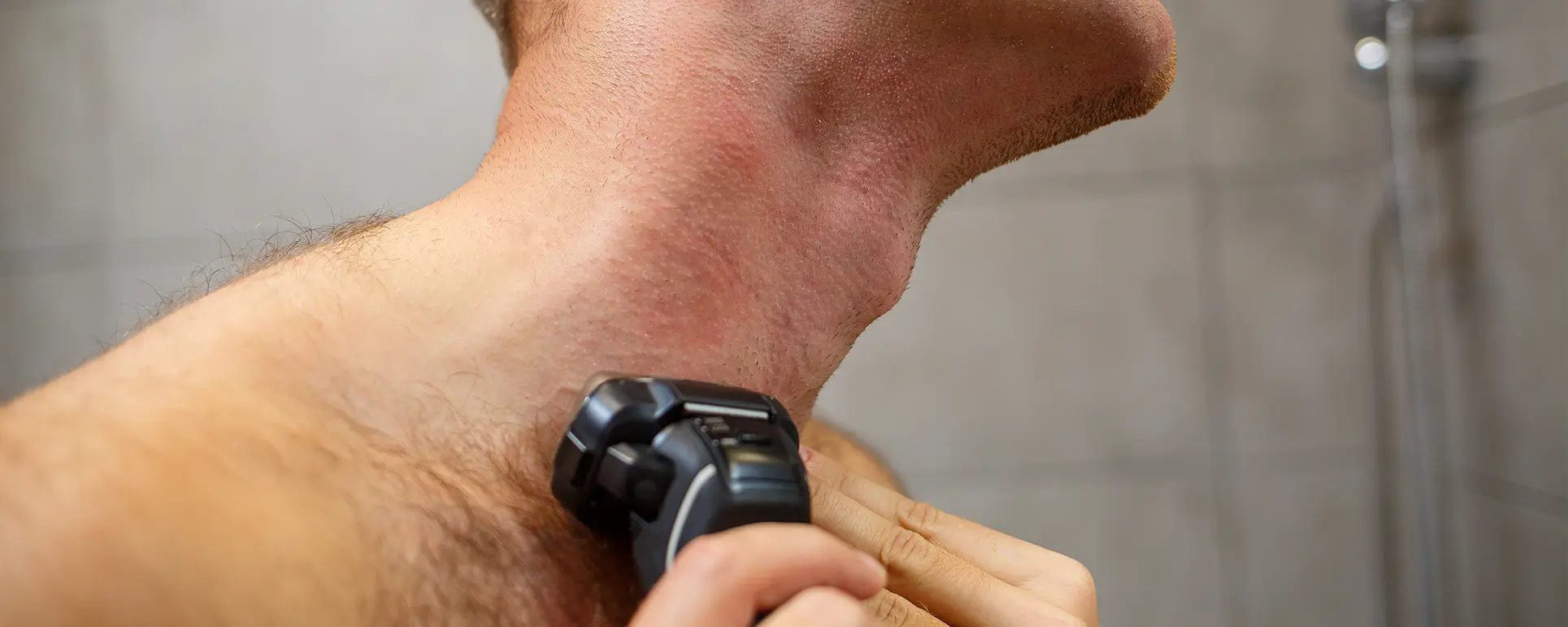Razor bumps and ingrown hairs are two of the most common side effects of hair removal, yet they remain some of the most frustrating to deal with. They often show up as red, irritated bumps that can resemble acne, making the skin look uneven and inflamed. For many, they’re not just a cosmetic concern they can be painful, itchy, and in some cases, lead to scarring or dark marks that linger long after the irritation has subsided.
These bumps tend to occur most often in areas where the skin is especially sensitive or where hair is coarse and curly, such as along the jawline and neck for men who shave frequently, or in the bikini area for women. In these regions, the sharp edge of a shaved or waxed hair can curl back into the skin, triggering inflammation. The result is not only uncomfortable but can also be embarrassing, particularly if breakouts occur on visible areas of the face.
While it may feel like a problem you just have to “put up with,” dermatologists emphasise that razor bumps and ingrown hairs are largely preventable with the right approach. Small changes in shaving techniques, pre- and post-care routines, and product choices can make a dramatic difference. And for stubborn or recurrent cases, professional treatments such as laser hair removal, topical prescriptions, or chemical peels can offer lasting relief.
In this comprehensive playbook, we’ll explore everything you need to know about keeping your skin smooth and bump-free. You’ll learn the science behind why razor bumps and ingrown hairs form, how to distinguish them from other skin conditions, and what practical steps you can take before, during, and after shaving or waxing to minimise risk. We’ll also cover dermatologist-recommended solutions for managing irritation, reducing hyperpigmentation, and preventing long-term damage to your skin barrier.
Whether you’re dealing with a cluster of bumps along your neck after a rushed morning shave, persistent irritation in your bikini line during swimsuit season, or the occasional ingrown hair on your face, this guide is designed to give you actionable answers. Think of it as your dermatologist-approved toolkit for smoother, healthier, and more confident skin no matter where your trouble spots are.
What Are Razor Bumps and Ingrown Hairs?

Although the terms are often used interchangeably, razor bumps and ingrown hairs are slightly different conditions, even though they share similar causes and appearances. Understanding the difference is important because it helps in choosing the right prevention strategies and treatments.
Razor Bumps (Pseudofolliculitis Barbae)
Razor bumps, medically known as pseudofolliculitis barbae, are small, raised red or flesh-coloured bumps that appear on the skin after shaving or waxing. They usually occur when freshly cut hairs grow back at an angle and re-enter the surrounding skin instead of rising straight out of the follicle. This penetration of the skin barrier triggers inflammation, resulting in irritation, swelling, and sometimes even pustules that resemble acne.
Razor bumps are particularly common in individuals with curly or coarse hair because the natural curl pattern makes it easier for hairs to bend back into the skin. Men who shave frequently, especially around the jawline and neck, often notice clusters of these bumps after using razors. Women may also experience them in the bikini area, armpits, or legs following hair removal. If left untreated, razor bumps can darken the skin (post-inflammatory hyperpigmentation) or even cause small scars over time.
Ingrown Hairs
An ingrown hair is a hair strand that, instead of growing outward through the skin’s surface, curls back or grows sideways beneath the skin. This misdirection can irritate the follicle and lead to inflammation. Ingrown hairs often appear as tender, round bumps that may be filled with pus, making them easy to confuse with pimples. In some cases, you can even see the trapped hair just beneath the skin’s surface.
Like razor bumps, ingrown hairs are more common in areas with thicker, curlier hair, such as the beard region, neck, chest, underarms, and bikini line. Shaving too closely, waxing improperly, or using blunt razors can increase the risk of ingrown hairs forming. Aside from being uncomfortable, they can also lead to secondary bacterial infections if the irritated area is scratched or picked.
How They Differ
While razor bumps are technically a type of ingrown hair, the difference lies in the mechanism. Razor bumps occur because the sharp, newly cut hair shaft re-enters the skin and grows inward. Ingrown hairs, on the other hand, often result from hair being trapped beneath dead skin cells, preventing it from breaking through the surface in the first place. Both conditions share common symptoms redness, tenderness, swelling, and itching but they are managed slightly differently.
Prevention Strategies

While razor bumps and ingrown hairs can be stubborn once they develop, the most effective approach is prevention. By adopting a consistent grooming routine and making a few mindful changes, you can significantly reduce your chances of irritation and keep your skin smoother for longer.
1. Shave Properly
How you shave is one of the most important factors in preventing razor bumps. A poor technique or dull razor often sets the stage for irritation.
- Shave in the direction of hair growth: Going against the grain might feel smoother initially, but it greatly increases the risk of hair curling back into the skin.
- Use a sharp, clean razor: A dull blade tugs at hair instead of cutting it cleanly, which can cause micro-tears in the skin and lead to bumps. Replace your razor blade after 5–7 shaves, or sooner if it starts to drag.
- Prepare the skin properly: Shaving after a warm shower softens both hair and skin, making the process less irritating.
- Avoid over-shaving: Running the blade over the same area multiple times may achieve a closer shave, but it also scrapes away protective layers of skin, making irritation and bumps far more likely.
2. Exfoliate Regularly
Exfoliation is key to preventing hairs from becoming trapped under dead skin cells. A consistent routine can help ensure that new hairs grow outward rather than curling back in.
- Gentle is best: Harsh scrubbing can cause more irritation, especially in sensitive areas like the bikini line or neck. Instead, use a mild scrub, exfoliating gloves, or a chemical exfoliant with ingredients like glycolic or salicylic acid.
- Frequency matters: Aim for 2–3 times a week depending on your skin type. Over-exfoliating can strip the skin’s protective barrier and worsen sensitivity.
- Focus on problem areas: Pay extra attention to spots where bumps frequently occur, such as the jawline, bikini line, or underarms.
3. Hydrate and Moisturise
Dry, tight skin is more prone to irritation and ingrown hairs. Keeping your skin hydrated both during and after shaving helps minimise friction and promotes faster healing.
- Use a hydrating shaving cream or gel: Look for products with soothing ingredients like aloe vera, glycerin, or chamomile to create a protective cushion between your razor and skin.
- Rinse with cool water afterwards: This helps close pores and calm irritation.
- Moisturise daily: Apply an alcohol-free aftershave, lightweight lotion, or balm immediately after shaving to lock in hydration and reduce inflammation. For added relief, consider using products containing niacinamide or hyaluronic acid.
4. Avoid Tight Clothing
Friction is a major culprit behind ingrown hairs, especially in the bikini area, thighs, and underarms. After shaving, skin is more vulnerable and easily irritated.
- Opt for loose-fitting fabrics: Breathable cotton underwear and looser trousers or skirts can help minimise rubbing against freshly shaved skin.
- Skip restrictive workout gear right after shaving: Tight leggings or swimwear can press hairs back into the skin and increase the risk of bumps.
- Allow skin to recover: Ideally, avoid shaving right before activities that require snug clothing or lots of movement.
By combining these strategies, you can greatly reduce your risk of developing razor bumps and ingrown hairs, while keeping your skin smoother, calmer, and healthier over time.
Safe Shaving Techniques

Even if you’re using the best skincare products, the way you shave plays a critical role in preventing razor bumps and ingrown hairs. A few small adjustments to your shaving routine can make the difference between irritated, bumpy skin and a smooth, comfortable finish.
Use the Right Tools
Your razor is the most important part of the process, so choosing wisely is essential.
- Opt for a high-quality razor: Razors with multiple blades and a built-in moisturising strip can glide more smoothly across the skin, reducing friction and irritation.
- Replace blades regularly: A dull blade tugs at the hair and scrapes the skin, leading to micro-cuts and an increased risk of ingrown hairs. Most dermatologists recommend changing blades every 5–7 shaves.
- Keep it clean: Always rinse your razor thoroughly after each use and store it in a dry place to prevent bacterial buildup, which can worsen irritation or even cause infection.
Shave After a Warm Shower
Timing matters just as much as technique.
- Soften the hair first: Warm water helps to relax your pores and soften the hair shaft, making it easier for the razor to cut through cleanly without tugging.
- Cleanse the skin: Washing with a mild cleanser before shaving removes dirt, oil, and dead skin cells, reducing the chances of razor drag and clogged follicles.
- Apply a protective barrier: Always use a shaving cream, gel, or oil to provide slip for the razor. This prevents unnecessary friction and lowers the risk of irritation.
Don’t Shave Too Closely
While many people aim for a “baby-smooth” shave, going too close can backfire.
- Leave a little length: When hair is cut too short, the sharp edge is more likely to curl back into the skin as it grows, resulting in razor bumps. Leaving a tiny bit of hair above the surface helps reduce this risk.
- Avoid pulling the skin taut: Stretching the skin to get a closer shave may seem effective in the moment, but it often encourages hairs to retract below the skin’s surface, making ingrowns more likely.
- Use light pressure: Let the razor do the work. Pressing down too hard only scrapes away protective layers of skin and increases irritation.
By following these safe shaving practices consistently, you’ll not only reduce your chances of developing bumps and ingrown hairs but also protect your skin barrier over time. The result is a smoother shave that feels as good as it looks.
Dermatologist Treatments for Razor Bumps and Ingrown Hairs
While proper shaving habits and at-home care go a long way in preventing irritation, some people still struggle with stubborn razor bumps and recurrent ingrown hairs. In these cases, dermatological treatments can provide relief, improve the appearance of the skin, and reduce the risk of long-term complications such as hyperpigmentation or scarring. Here are the most common medical approaches:
Topical Steroids or Retinoids
- Topical corticosteroids: When inflammation is severe, a dermatologist may prescribe a mild corticosteroid cream or ointment. These reduce redness, swelling, and itching, calming the irritated area.
- Topical retinoids: Retinoids (such as tretinoin or adapalene) increase cell turnover, helping to clear clogged follicles and prevent hairs from becoming trapped under the skin. They also improve skin texture and reduce post-inflammatory hyperpigmentation that often accompanies razor bumps.
Antibiotic Creams or Oral Medications
- Topical antibiotics: If an ingrown hair becomes infected, your dermatologist may recommend an antibiotic cream or gel (such as clindamycin or mupirocin). These help kill bacteria and reduce the risk of further spread.
- Oral antibiotics: For more widespread or stubborn infections, short courses of oral antibiotics may be necessary to clear deeper skin infections caused by ingrown hairs.
Chemical Peels
- Light chemical peels: Dermatologists sometimes recommend chemical peels containing glycolic acid, salicylic acid, or lactic acid. These gently exfoliate the skin, removing dead cells that trap hairs and reducing the risk of bumps.
- Benefits beyond exfoliation: Regular treatments can also fade dark marks left behind by previous razor bumps, helping to even out skin tone over time.
Laser Hair Removal
- One of the most effective long-term solutions for recurring razor bumps and ingrown hairs is laser hair removal.
- The laser targets hair follicles, reducing hair growth and thereby eliminating the root cause of the problem.
- Particularly beneficial for people with coarse or curly hair, this treatment can dramatically improve both the frequency and severity of razor bumps.
Extraction of Ingrown Hairs
- In cases where hairs remain trapped beneath the skin and cause painful or persistent bumps, dermatologists may carefully release them using sterile tools.
- This procedure should never be attempted at home, as improper removal can lead to infection or scarring.
Other Professional Treatments
- Prescription-strength exfoliants: Stronger formulations of glycolic acid or salicylic acid may be prescribed for those who don’t respond well to over-the-counter options.
- Corticosteroid injections: For severe inflammation or keloid-prone skin, tiny injections of corticosteroids may be given directly into the bump to flatten and calm the area.
When to Consider Laser Hair Removal
For many people, razor bumps and ingrown hairs are occasional nuisances that improve with better shaving habits, exfoliation, and topical care. But if these issues become chronic, recurring, or start leaving behind dark marks and scars, it may be time to consider a more permanent solution laser hair removal.
How Laser Hair Removal Works
Laser hair removal uses concentrated beams of light to target the pigment in hair follicles. The heat from the laser damages the follicle enough to slow down or completely stop future hair growth. Over a series of sessions, the treated hairs become finer, lighter, and less likely to grow back into the skin. With fewer active follicles, the risk of ingrown hairs and razor bumps decreases dramatically.
Why It Helps with Razor Bumps and Ingrown Hairs
- Targets the root cause: Since bumps form when hairs grow back into the skin, reducing or eliminating hair growth directly addresses the problem.
- Less irritation: Unlike shaving or waxing, laser treatment doesn’t cut or pull hairs, meaning the skin experiences far less trauma.
- Improves skin texture and tone: Many people notice that dark spots, scars, and rough patches caused by repeated irritation begin to fade after consistent treatment.
Best Areas for Treatment
Laser hair removal is particularly effective in sensitive, high-friction zones where bumps and ingrown hairs often occur:
- Bikini line: One of the most common problem areas, where coarse hair and tight clothing frequently lead to irritation.
- Neck and jawline: Especially beneficial for men who shave daily and struggle with recurring bumps in the beard area.
- Face: For women dealing with unwanted facial hair, laser can reduce irritation from constant plucking, waxing, or threading.
Things to Keep in Mind
- Multiple sessions are required: Because hair grows in cycles, most people need 6–8 treatments spaced several weeks apart for optimal results.
- Works best on certain hair types: Lasers target pigment, so the treatment tends to be most effective on darker hair against lighter skin. However, advancements in technology now make it possible to safely treat a wider range of skin tones.
- Professional guidance is essential: Always seek treatment from a qualified dermatologist or licensed practitioner. Incorrect use of lasers can result in burns, pigmentation changes, or scarring.
Final Thought: Achieving Smooth, Bump-Free Skin
Razor bumps and ingrown hairs can be prevented with the right techniques, but if they persist, it’s important to seek professional help. You can get in touch with a dermatologist in London to discuss personalised treatments, from topical solutions to laser hair removal, for smoother, irritation-free skin.
References:
- Ogunbiyi, A. (2019) Pseudofolliculitis barbae: current treatment options. Clinical, Cosmetic and Investigational Dermatology, 12, pp. 305–312.
Available at: https://pmc.ncbi.nlm.nih.gov/articles/PMC6585396/ - Kravitz, S., Halder, R.M., Taylor, S.C. & Alexis, A.F. (2023) Short- and long-term effects of laser hair removal on pseudofolliculitis barbae. Journal of the American Academy of Dermatology.
Available at: https://www.jaad.org/article/S0190-9622%2823%2901706-1/fulltext - Rendon, M.I. & Roberts, J. (2010) Evidence and considerations in the application of chemical peels. Dermatologic Surgery, 36(1), pp. 1–18. doi: 10.1111/j.1524-4725.2009.01311.x
Available at: https://pmc.ncbi.nlm.nih.gov/articles/PMC2921757/ - Lin, H.S., Yang, C.H., Chuang, Y.H. & Wu, C.S. (2021) Interventions for bacterial folliculitis and boils (furuncles and carbuncles). The Journal of Clinical and Aesthetic Dermatology, 14(8), pp. 30–37. Available at: https://pmc.ncbi.nlm.nih.gov/articles/PMC8130991/
